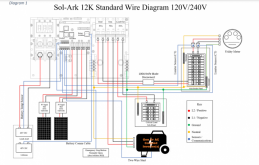Hello everyone!
Those who have worked with a Sol-Ark inverter knows that their manuals can be confusing at times. I am setting out to create an all-inclusive Q&A/Explanation document that should help all Sol-Ark users and DIYers get their systems setup quickly and optimally.
Please reply to this thread with some of the issues/experiences you faced when installing your units to help others looking to DIY install a Sol-Ark. I know these units are rising in popularity, so having good information for the DIY community is essential for us to be successful!
Some of the issues that I faced when installing my inverter were the following:
- Do I need a resistor to pre-charge the capacitors?
- During testing before install my inverter gave me an F03 or F04 error (GFDI Failure) and wont turn on!
- Where should I ground my neutral and ground wires?
- My batteries don't have closed loop communications with the inverter. Are they still compatible?
- I'm off-grid! Should I use the "GEN" input or "GRID" input for my backup generator?
- How do I setup generator peak shaving when the generator is connected to the grid input? Should I now use "GRID PEAK SHAVING" or "GEN PEAK SHAVING"
- Is peak shaving per-leg or is it on both legs combined? Does the inverter balance the load on the phases of the generator?
- With my generator running, why aren't my batteries starting to charge?
- Can I run loads directly off my generator, but still use the Sol-Ark for Generator Peak Shaving?
- My transfers from generator power back to inverter take a long time; my lights are flickering! Why?!?!?!
- What direction should I be installing the hall-effect current transformers? Where should I install them? Do I need them?
- What does the big ferrite cores go? Should they go over both wires? Do I need them for Non-EMP hardened inverters?
- My house used to run fine on a 8kw transformer-based inverter, now the sol-ark is showing overloads! Why!
- How does phase-balance effect a transformerless inverter?
I will be breaking these down in the next couple of days as time permits, with great detail with diagrams and very thorough explanations, so the next 4 posts will be reserved. Please comment any of the issues/problems you faced - I will update these posts to contain as much information as possible right up front!




